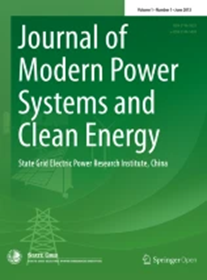Revisiting Capacity Value of Variable Renewable Energy Generation in Power Systems with High Renewable Energy Penetration
IF 6.1
1区 工程技术
Q1 ENGINEERING, ELECTRICAL & ELECTRONIC
Journal of Modern Power Systems and Clean Energy
Pub Date : 2025-04-09
DOI:10.35833/MPCE.2024.001101
引用次数: 0
Abstract
Adequacy is a key concern of power system planning, which refers to the availability of sufficient facilities to meet demand. The capacity value (CV) of variable renewable energy (VRE) generation represents its equivalent contribution to system adequacy, in comparison to conventional generators. While VRE continues to grow and increasingly dominates the generation portfolio, its CV is becoming non-negligible, with the corresponding impact mechanisms becoming more complicated and nuanced. In this paper, the concept of CV is revisited by analyzing how VRE contributes to power system balancing at a high renewable energy penetration level. A generalized loss function is incorporated into the CV evaluation framework considering the adequacy of the power system. An analytical method for the CV evaluation of VRE is then derived using the statistical properties of both hourly load and VRE generation. Through the explicit CV expression, several critical impact factors, including the VRE generation variance, source-load correlation, and system adequacy level, are identified and discussed. Case studies demonstrate the accuracy and effectiveness of the proposed method in comparison to the traditional capacity factor-based methods and convolution-based methods. In the IEEE-RTS79 test system, the CV of a 2500 MW wind farm (with 40% renewable energy penetration level) is found to be 6.8% of its nameplate capacity. Additionally, the sensitivity of CV to various impact factors in power systems with high renewable energy penetration is analyzed.高可再生能源渗透率电力系统中可变可再生能源发电容量值的再研究
充足性是电力系统规划的一个关键问题,它指的是有足够的设施来满足需求。与传统发电机相比,可变可再生能源(VRE)发电的容量值(CV)代表其对系统充分性的等效贡献。在VRE持续增长并日益主导发电组合的同时,其CV也变得不可忽略,相应的影响机制也变得更加复杂和微妙。本文通过分析VRE在可再生能源高渗透水平下对电力系统平衡的贡献,重新审视了CV的概念。考虑到电力系统的充分性,将广义损失函数纳入CV评估框架。然后,利用每小时负荷和VRE产生的统计特性,导出了VRE CV评估的分析方法。通过显式CV表达式,确定并讨论了几个关键影响因素,包括VRE生成方差、源负荷相关性和系统充分性水平。与传统的基于容量因子的方法和基于卷积的方法相比,实例研究证明了该方法的准确性和有效性。在IEEE-RTS79测试系统中,发现2500mw风电场(可再生能源渗透率为40%)的CV为其铭牌容量的6.8%。此外,还分析了可再生能源普及率高的电力系统中CV对各种影响因素的敏感性。
本文章由计算机程序翻译,如有差异,请以英文原文为准。
求助全文
约1分钟内获得全文
求助全文
来源期刊

Journal of Modern Power Systems and Clean Energy
ENGINEERING, ELECTRICAL & ELECTRONIC-
CiteScore
12.30
自引率
14.30%
发文量
97
审稿时长
13 weeks
期刊介绍:
Journal of Modern Power Systems and Clean Energy (MPCE), commencing from June, 2013, is a newly established, peer-reviewed and quarterly published journal in English. It is the first international power engineering journal originated in mainland China. MPCE publishes original papers, short letters and review articles in the field of modern power systems with focus on smart grid technology and renewable energy integration, etc.
 求助内容:
求助内容: 应助结果提醒方式:
应助结果提醒方式:


